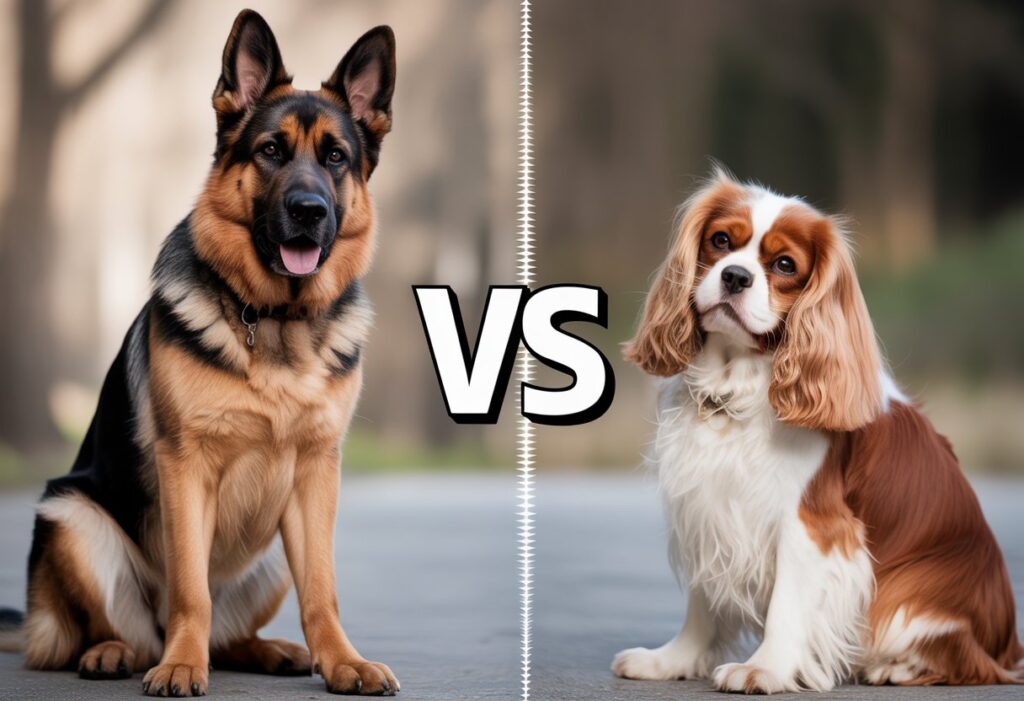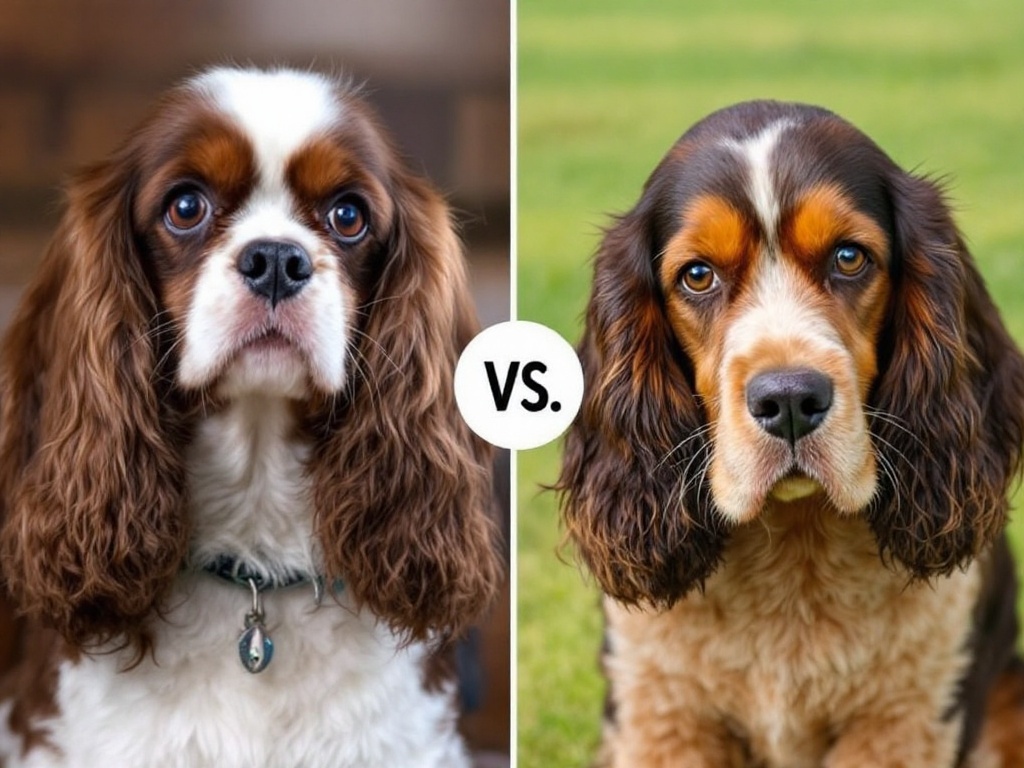Choosing between a Cavalier King Charles Spaniel and a Coton De Tulear can feel overwhelming if you want an affectionate, friendly companion. Both breeds make wonderful pets, but the right choice really depends on your lifestyle, space, and how much grooming and energy you’re up for.
You’ll want to compare their needs and personalities to find the best fit.
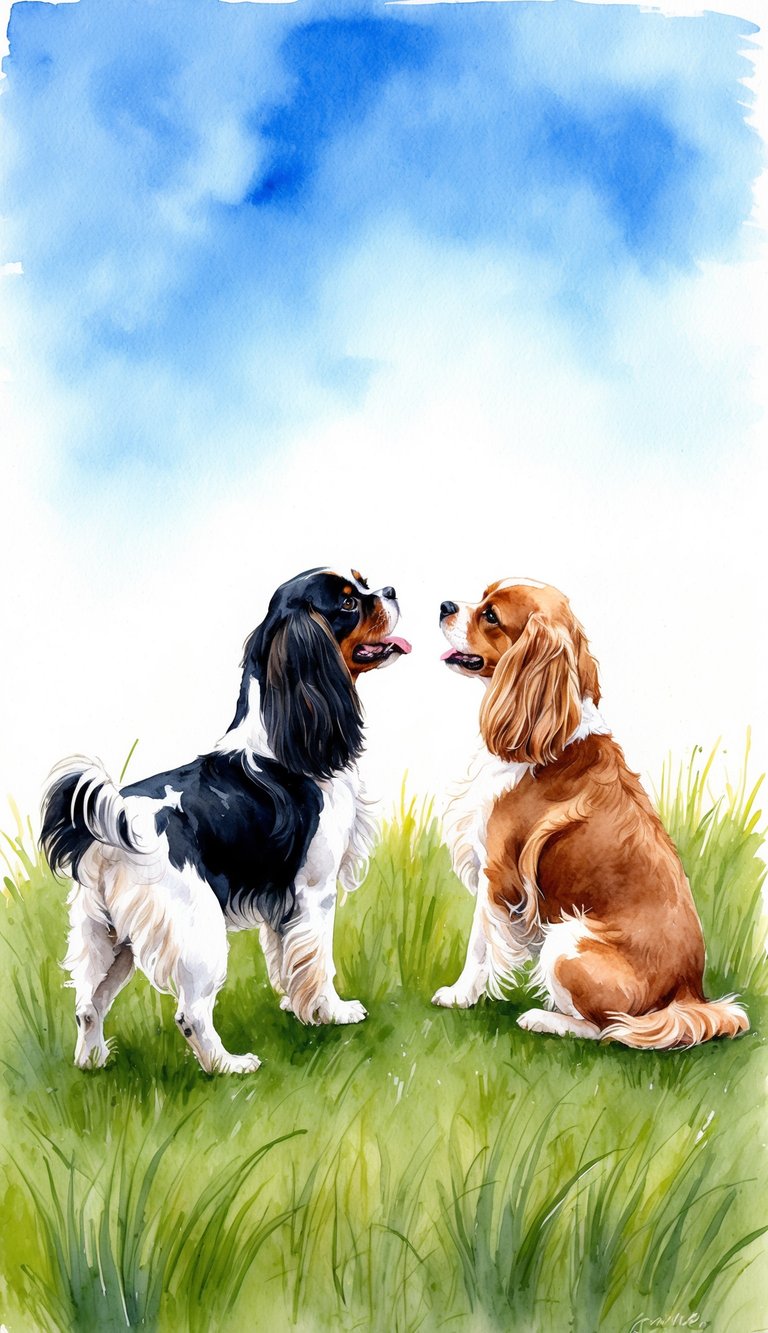
The Cavalier King Charles Spaniel is gentle, social, and eager to please. The Coton De Tulear stands out for its cheerful nature and that unmistakable cotton-like coat.
Training needs, size, and grooming requirements can really make a difference in your decision. Curious which breed fits your family and routine? Check out this comparison.
Breed Origins and History
These two small companion breeds have unique backgrounds. Their histories are tied to different parts of the world and different roles in society.
Their origins shape their temperament, looks, and even their popularity today.
Cavalier King Charles Spaniel Background
The Cavalier King Charles Spaniel comes from the United Kingdom and has roots in the royal courts of England. Early toy spaniels were beloved as companion dogs in the 16th, 17th, and 18th centuries.
The breed is linked closely to King Charles II, who was often seen with small spaniels during his reign. In the 1920s, breeders started reviving the traditional look shown in old paintings—longer noses and flatter skulls.
That led to the modern Cavalier King Charles Spaniel recognized by kennel clubs worldwide. The American Kennel Club officially recognized the breed in 1995.
Today, the Cavalier is a gentle, affectionate dog that still feels a bit regal but is totally approachable. You can dig deeper into the Cavalier King Charles Spaniel origins if you want more history.
Coton de Tulear Background
The Coton de Tulear is native to Madagascar. Its name comes from the port city of Tuléar (now Toliara) and the French word “coton” for cotton, which definitely fits their soft, fluffy coat.
The breed developed as a companion for Madagascar’s nobility back in the 17th and 18th centuries. According to breed lore, the Coton de Tulear became known as the “Royal Dog of Madagascar” because it was so common in royal households.
The breed stayed under the radar outside Madagascar until the 1970s. Then it started showing up in Europe and North America.
Now, the American Kennel Club recognizes the Coton de Tulear. People love them for their friendly nature and that signature cotton-like fur. You can find more about their story at Coton de Tulear history.
Physical Characteristics
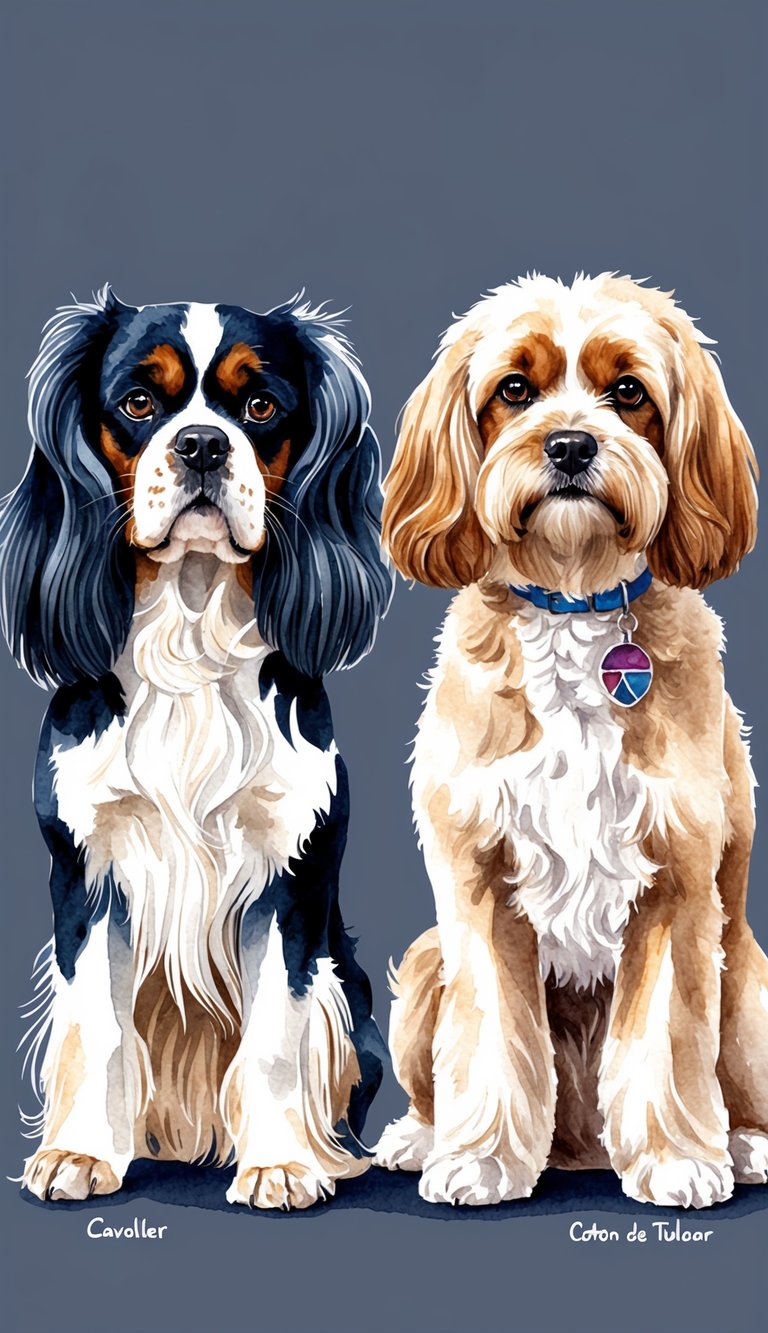
Cavalier King Charles Spaniels and Coton De Tulears both have soft expressions and charming looks. But you’ll spot differences in size, coat, and other features right away.
Their weight, fur texture, and colors might sway your grooming routine or show preferences.
Size and Weight Comparison
The Cavalier King Charles Spaniel is a small dog, but stands a bit taller and heavier than the Coton De Tulear. A healthy adult Cavalier usually measures 12 to 13 inches at the shoulder and weighs 13 to 18 pounds.
They’ve got a graceful, balanced body, which makes them popular at home and in the show ring. The Coton De Tulear is more compact and lighter.
An adult Coton typically stands 9 to 11 inches tall and weighs 8 to 13 pounds. Their bodies are a little longer than they are tall, so they look sturdy but still small.
If you want a slightly smaller lap dog that’s easy to carry or travel with, the Coton might be your pick. Both breeds fit well in apartments or small homes.
Cavaliers are a bit sturdier, while Cotons are lightweight and easy to scoop up. You can check out their stats side by side at Dogell’s breed comparison.
Coat Type and Colors
The Cavalier King Charles Spaniel has a long, silky coat that lies flat or with a slight wave. Their fur feels soft and needs regular brushing to avoid mats.
Cavaliers come in four official color patterns: Blenheim (chestnut and white), Tricolor (black, white, and tan markings), Ruby (solid red), and Black & Tan. The Coton De Tulear has a unique fluffy, cotton-like coat.
Their hair is long, dense, and super soft—definitely not silky. It’s usually slightly wavy and stands out for its cottony texture.
Most Cotons are all white, but you’ll sometimes see a bit of grey or light tan, especially around the ears. Both breeds don’t shed much, but they do need frequent grooming.
Cotons may need more trimming, while Cavaliers often have feathered legs and ears.
Distinctive Features
Cavalier King Charles Spaniels have large, dark, round eyes and a sweet face. Their long, feathered ears frame their cheeks, and they’ve got a slightly rounded skull.
Many Cavaliers have tan markings on their face and legs, especially in the Tricolor and Black & Tan varieties. Cotons have dark, expressive eyes, a black nose, and fluffy drop ears.
Their long hair gives them a playful, tousled look. The Coton’s topline can be slightly arched, and their tail is usually carried high and curled over the back.
Cavaliers look more elegant and classic, while Cotons seem playful and a bit quirky thanks to their texture. Both breeds draw attention at a dog show, but each has its own vibe.
Temperament and Personality
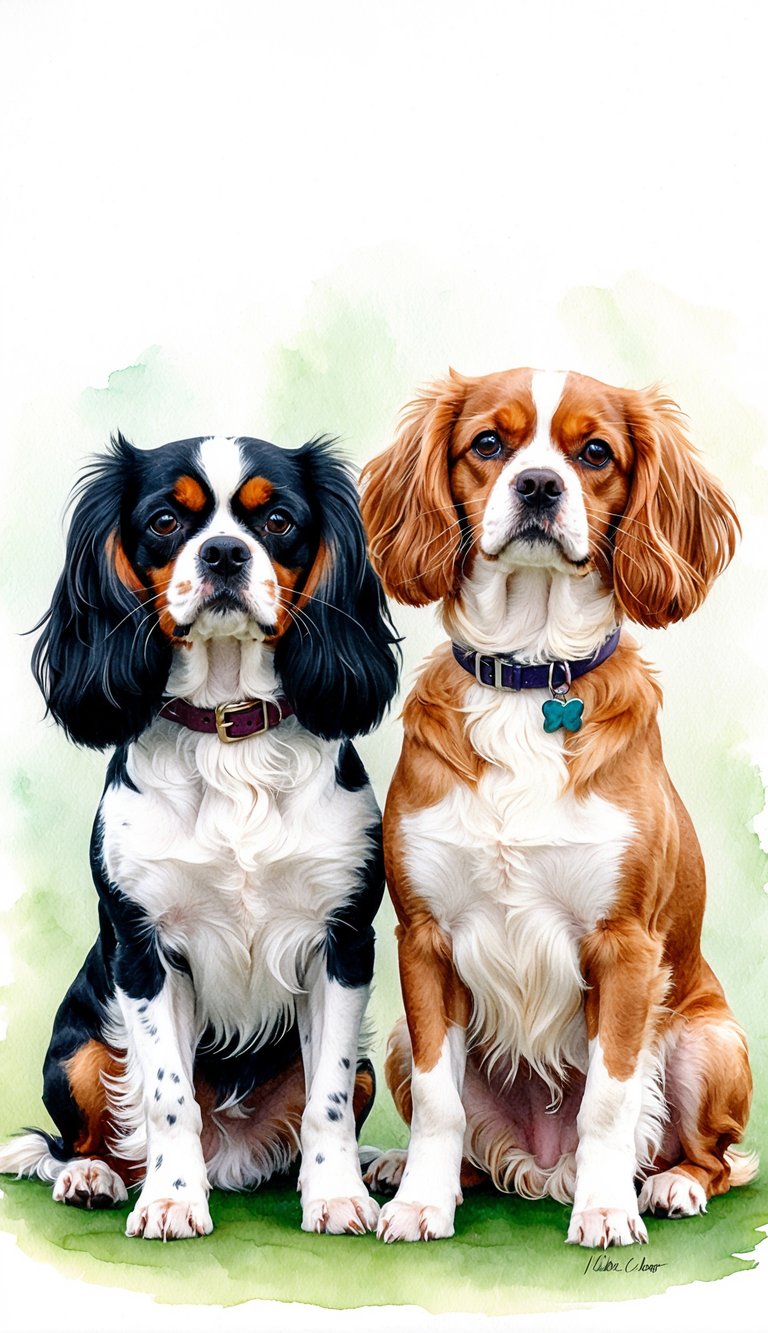
Cavalier King Charles Spaniels and Coton de Tulears both have friendly, affectionate personalities. They’re easygoing, gentle with kids, and fit right in with most families.
Social Traits
The Cavalier King Charles Spaniel is cheerful and loves being close to people. This breed is people-oriented and will often follow you from room to room.
Cavaliers greet family and strangers alike with a wag and are quick to form bonds. The Coton de Tulear is just as friendly, but tends to be a bit more playful.
They thrive in social settings and sometimes act like little clowns to get your attention. Cotons love making you smile during playtime or walks.
Both breeds hate being left alone for long stretches. Cavaliers especially crave company and can get anxious if left solo.
If you’re gone a lot, you might want to consider a more independent breed like the Bichon Frise or Shih Tzu. Beagles and Yorkshire Terriers are also friendly but a bit less needy.
Family Compatibility
Both breeds adapt well to family life. Cavalier King Charles Spaniels are eager to please and settle into most homes without fuss.
They’re gentle and rarely show aggression toward family members. Coton de Tulear dogs are tolerant and love snuggling on the couch.
They’re small and calm indoors, so they don’t need a ton of space. Cotons’ easygoing attitude works for families of any size, including seniors or first-time dog owners.
Both breeds want to be part of your daily routine. They’ll follow you around and don’t like being left out of the action.
If your family wants a companion who’s always involved, you can’t go wrong with either. For more on their family compatibility, check Coton de Tulear vs Cavalier King Charles Spaniel.
Interaction With Children and Pets
Cavalier King Charles Spaniels are patient and gentle with children. They tolerate hugs and petting, and rarely show signs of stress.
This makes them good dogs for families with young kids, as long as play is supervised. The Coton de Tulear is similar—playful with kids and calm at home.
They join in on games and usually get along with other dogs and even cats. Cotons are welcoming, even to new pets in the house.
If you have other pets like a Beagle, Yorkshire Terrier, or Shih Tzu, both breeds can adapt. Early socialization helps them accept new arrivals and keeps things positive.
You can read more about how friendly these breeds are at Cavalier King Charles Spaniel vs Coton De Tulear.
Health and Lifespan
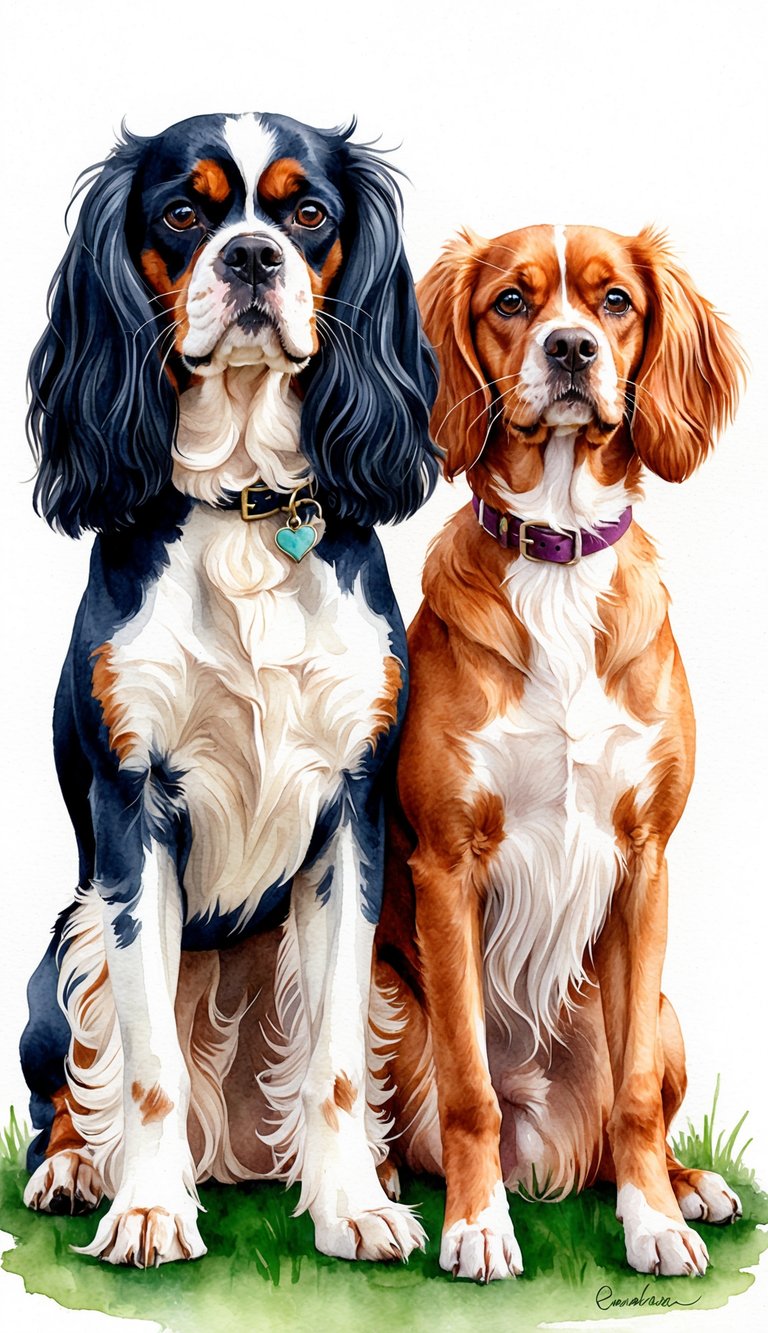
Cavalier King Charles Spaniels and Coton de Tulears each have their own health profiles and life expectancies. Knowing what to expect can help you spot issues early and plan for your dog’s care.
Common Health Issues
Cavalier King Charles Spaniels are prone to heart problems, especially mitral valve disease. They can also develop eye issues like cataracts or retinal problems, and sometimes joint troubles such as luxating patella.
Coton de Tulears are generally healthy but can still have some issues. These might include hip dysplasia, allergies, and ear infections—those floppy ears don’t help.
Both breeds need yearly checkups with a vet. Early detection helps manage symptoms and keeps your dog feeling good.
Grooming and regular ear cleaning, especially for Cotons, are important for prevention.
| Health Issue | Cavalier King Charles Spaniel | Coton de Tulear |
|---|---|---|
| Heart Disease | Common | Rare |
| Eye Problems | Moderate | Not common |
| Joint Issues | Some cases | Rare |
| Allergies | Not common | Moderate |
| Ear Infections | Low risk | Moderate risk |
Average Lifespan
The average lifespan for a well-cared-for Cavalier King Charles Spaniel is about 10-14 years. Some live longer, but heart problems can lower their life expectancy.
Most kennel club statistics back up these numbers.
A Coton de Tulear tends to live longer, usually 14 to 16 years. Some Cotons, based on breed records and stories from owners, might even reach 19.
Both breeds do better with regular vet visits, a balanced diet, and daily exercise. Genetics matter, but everyday care really makes a difference.
Breed-Specific Medical Concerns
Cavalier King Charles Spaniels face a few breed-specific medical risks. Mitral valve disease is the big one, often starting in middle age.
Syringomyelia, a neurological condition, can also show up in this breed and cause pain or coordination problems.
Coton de Tulears sometimes deal with hip dysplasia, but this is less common than in larger breeds. They don’t have as many known hereditary health risks as Cavaliers, but it’s still smart for breeders to do health screenings.
A vet who understands these breeds can help spot issues early. Ask breeders for health clearances when you’re adopting.
Grooming and Maintenance
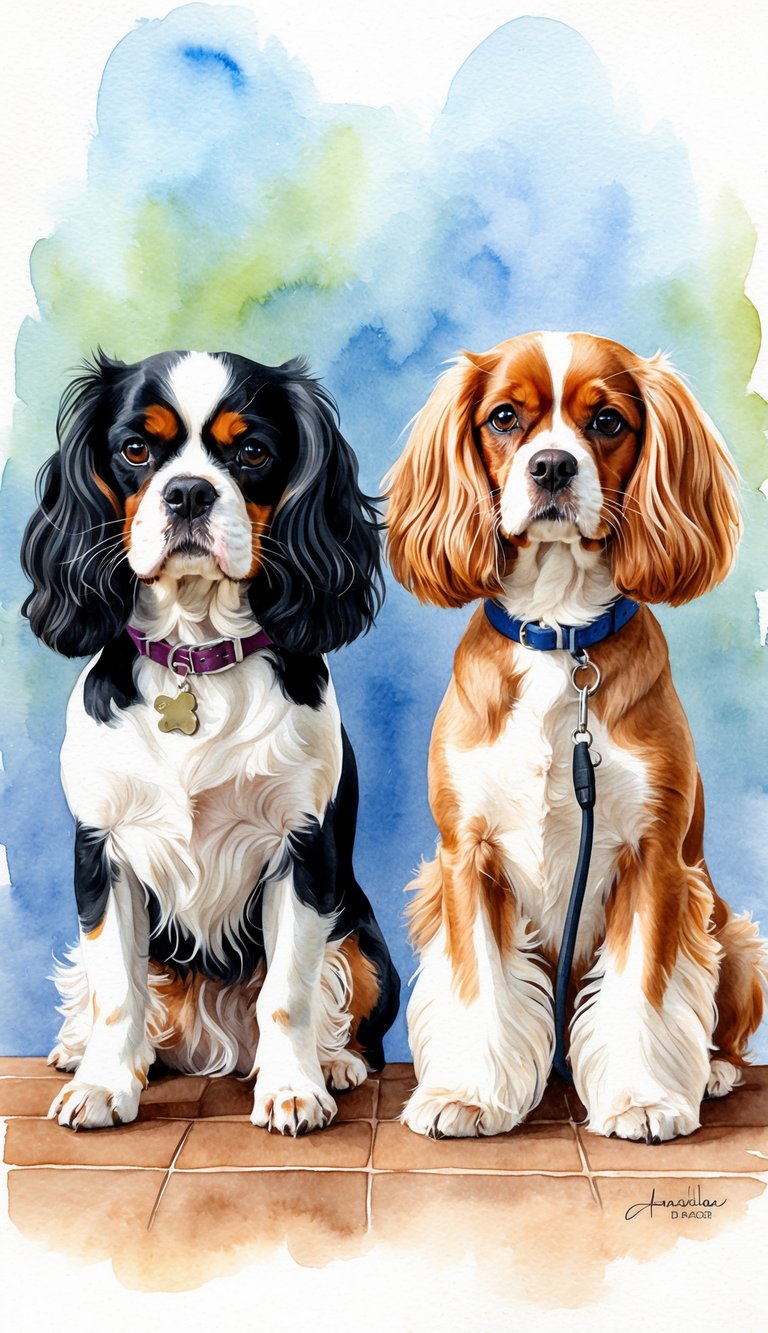
Cavalier King Charles Spaniels and Coton de Tulears each have their own grooming quirks. Regular care prevents tangles, helps with shedding, and keeps your dog feeling and smelling good.
Coat Care Requirements
The Cavalier King Charles Spaniel’s coat is silky and medium-length. Brushing at least three times a week keeps their fur soft and removes tangles.
Check for mats behind the ears and under the legs since their fur loves to bunch up there.
Coton de Tulears have a long, cotton-like double coat that tangles easily if you don’t brush daily. Many owners trim their coat for easier care.
A monthly bath keeps their coat clean and fluffy.
For comparison, the Bichon Frise sports a fluffy white coat that also needs daily brushing and regular trims. All three breeds benefit from a professional groomer every couple of months.
Shedding and Allergies
Cavalier King Charles Spaniels shed moderately all year. Shedding usually ramps up during seasonal changes.
You’ll find some hair on your clothes and couch. They’re not hypoallergenic.
Coton de Tulears barely shed. This makes them a better pick for families with allergies.
Their low-shedding coat means less hair around the house. Bichon Frises are similar—low shedding and considered hypoallergenic.
If allergies are a worry, the Coton de Tulear loses less hair than the Cavalier. Still, regular grooming helps keep allergens down in any breed.
General Hygiene
Routine hygiene is a must for all breeds. Check and clean their ears weekly to prevent infections, especially if your dog has floppy ears.
Trim nails every three to four weeks, depending on how fast they grow. Brush their teeth a few times a week with dog toothpaste to keep breath fresh and teeth healthy.
Bathing your dog regularly—but not too often—helps keep their coat shiny and skin healthy. Good hygiene also helps you spot health issues early and keeps your dog comfy.
Exercise and Activity Needs
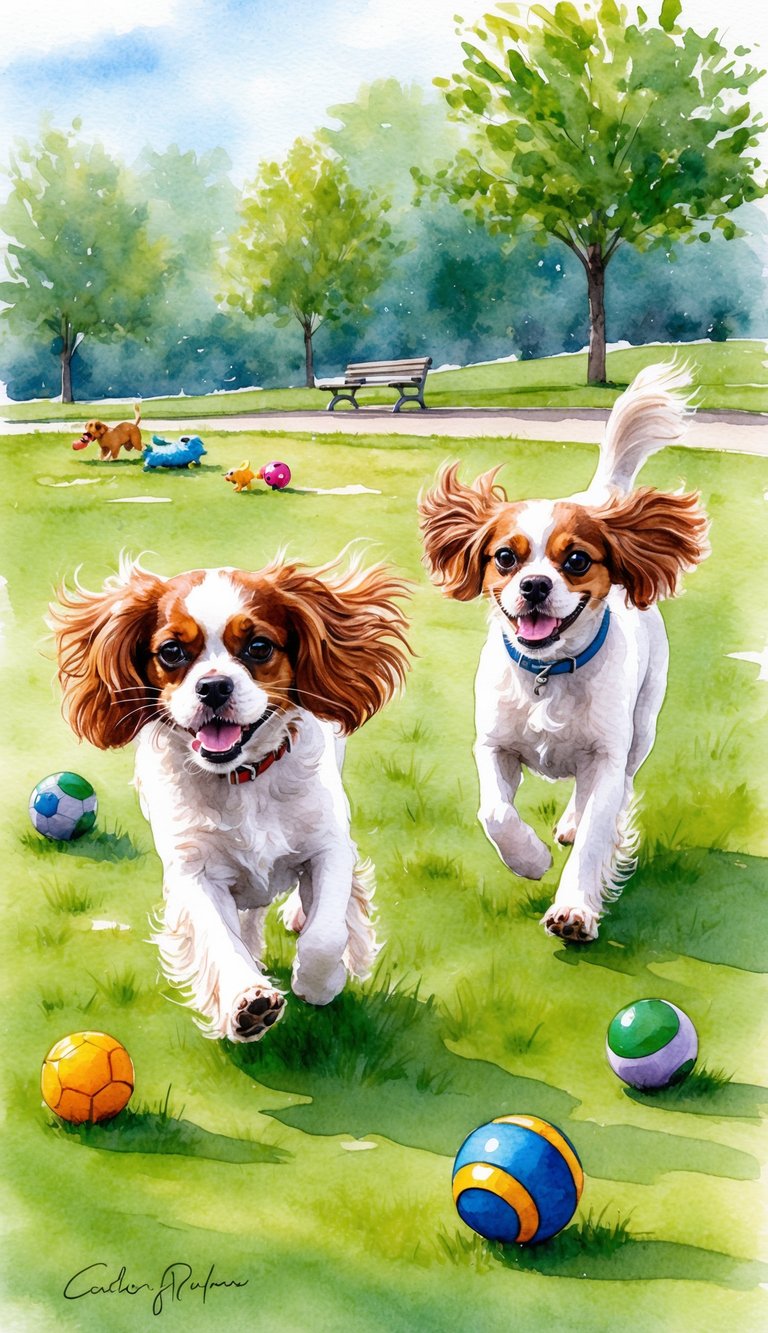
Both the Cavalier King Charles Spaniel and Coton de Tulear have moderate energy. Their days should mix walks, playtime, and a few bursts of more active games.
A Labrador Retriever or Border Collie? They need way more intense exercise.
Daily Exercise Recommendations
The Cavalier King Charles Spaniel does best with 30 to 60 minutes of activity daily. This can mean a walk around the block, some time in a fenced yard, or a game indoors.
After their outing, these dogs are usually happy to chill with you.
Coton de Tulears also need regular movement, but their energy usually sits at low to medium. They’re pretty content with walks and playtime that last about 30 minutes.
Regular exercise keeps them from getting bored or putting on extra weight.
Compared to big breeds like the Labrador Retriever or Border Collie, Cavaliers and Cotons need much less. Labs and Collies can want more than an hour of hard exercise each day. You can read more at Dog Learn.
Suitable Activities and Games
Both breeds love easygoing play. Fetch, hide and seek, and treat puzzles are always hits.
A game of tug-of-war or learning simple tricks helps keep their minds busy.
Cavalier King Charles Spaniels especially love chasing balls or interactive toys. Food puzzles and training sessions work well for them.
Coton de Tulears like gentle play and love exploring new spots on walks. They respond well to short, positive training sessions.
Unlike Border Collies or Labs, you don’t need to plan for intense agility or long runs. Gentle games and walks are more than enough for these companion breeds.
For more on what to expect, check out this breed exercise comparison.
Trainability and Intelligence

Both the Cavalier King Charles Spaniel and the Coton de Tulear are known for being smart and eager to please. Training usually goes smoothly, though each breed has its own quirks and motivations.
Ease of Training
The Cavalier King Charles Spaniel is easy to train, especially if you use positive reinforcement. They want to make you happy and love being around people.
Their gentle nature means treats and praise work much better than harsh corrections.
The Coton de Tulear is also easy to train. Cotons want to please and quickly pick up on routines.
They’re social and enjoy activities with their family. Short, fun training sessions usually get the best results—you’ll see progress if you’re consistent and patient.
Both breeds are smart, but they’re not quite in the same league as the Border Collie or German Shepherd when it comes to advanced tricks or working tasks. Still, if you want a family pet who’s calm and friendly, both Cavaliers and Cotons are solid picks. For more, check out this Cavalier King Charles Spaniel vs Coton De Tulear comparison.
Learning Styles and Skillsets
Cavalier King Charles Spaniels learn best with gentle, steady methods. They don’t respond well to harsh corrections and do much better when you encourage them.
These dogs shine at basic obedience, simple tricks, and even therapy dog work. They like games that involve people or short training sessions.
Coton de Tulear is clever and adapts well to new commands and situations. Cotons pick things up through repeated routines and positive reinforcement.
They enjoy learning practical behaviors, fun tricks, and sometimes even a bit of agility.
Neither breed matches the advanced skills of a Border Collie or German Shepherd, who often master complex commands and excel in sports or police work. But for most families, Cavaliers and Cotons are easy to train and can learn everything you need at home. You can see a temperament comparison for both breeds if you want to dig deeper.
Living Environment Suitability
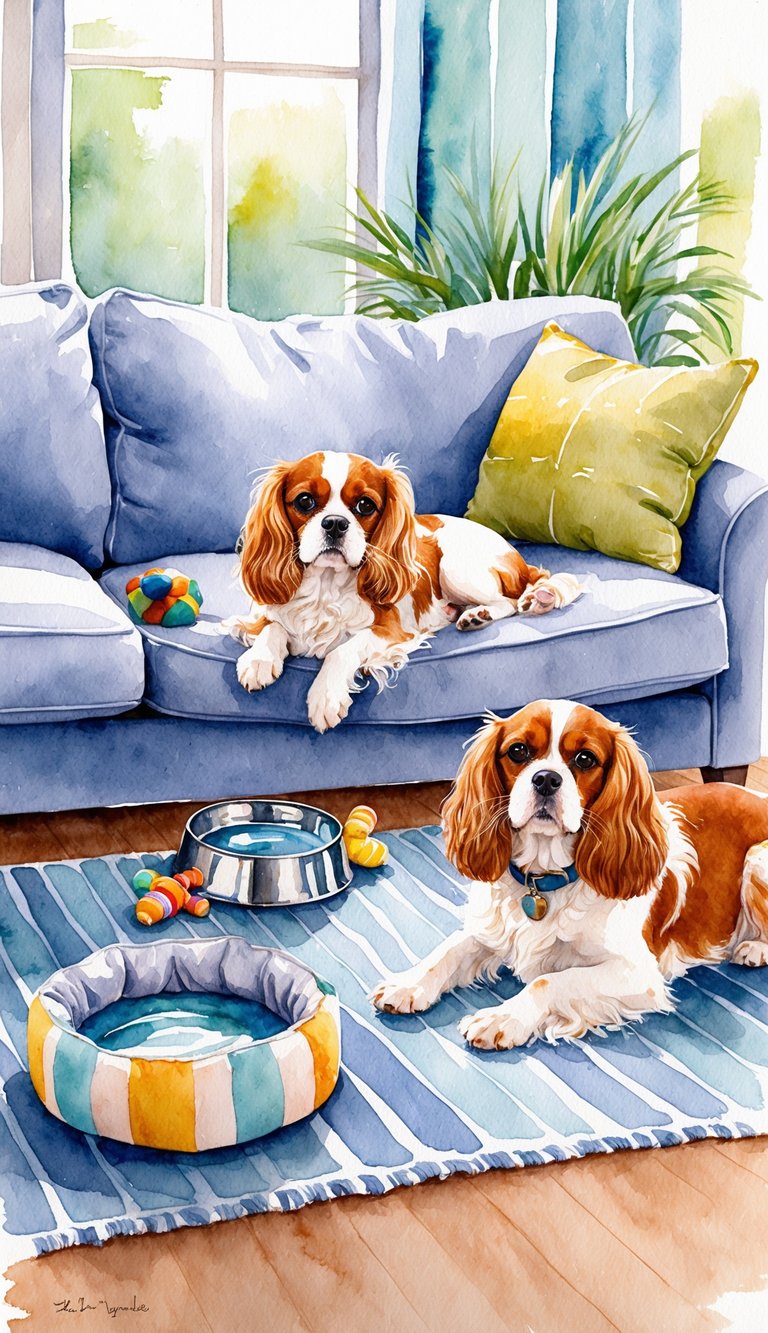
The Cavalier King Charles Spaniel and the Coton de Tulear fit well into different types of homes. They’re adaptable, whether you have an apartment or a house with a yard.
Apartment Living
Both breeds do just fine in apartments. Their small size and friendly personalities make them great companions for city dwellers.
They don’t need tons of space indoors and are happy as long as they get their daily walks and some attention.
The Coton de Tulear is especially quiet and doesn’t bark much—great if you live close to neighbors. They can handle some alone time but will miss you if left too long.
The Cavalier King Charles Spaniel loves being near people, so don’t leave them alone for hours on end.
For comparison, the Pug and French Bulldog also work well in apartments thanks to their calm personalities and compact size. Short exercise sessions indoors or outside usually do the trick.
If you live upstairs, these breeds handle stairs pretty well, though older Pugs and French Bulldogs with joint issues may struggle. Keep indoor play gentle and use interactive toys to burn off energy.
Home With Yard
If you have a yard, both breeds will enjoy it. The Cavalier King Charles Spaniel loves to explore—just keep an eye on them since they might chase birds or try to squeeze through small gaps.
A secure fence is a must.
The Coton de Tulear likes to play outside but isn’t as likely to dig or escape. Their light coat can pick up dirt, so brush them often or check for debris after playtime.
They’ll usually follow you back inside since they like being with family.
Pugs and French Bulldogs enjoy open space, but they tire quickly, especially in warm weather. Watch for signs of overheating or fatigue when they’re outside.
Always provide water and shade, and never leave them out in the heat for long.
Having a yard makes potty breaks easier, but none of these breeds require a yard if you’re committed to daily walks and indoor play.
Breed Popularity and Recognition
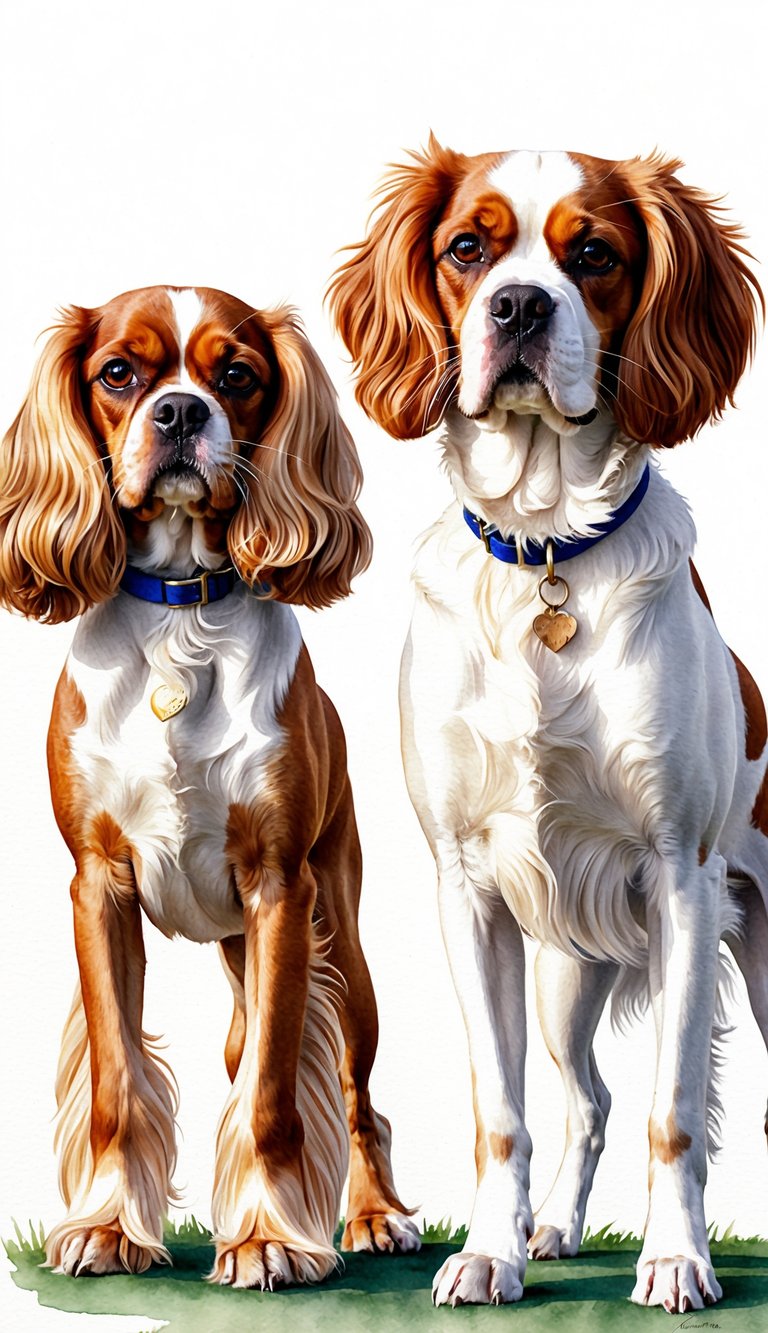
Both the Cavalier King Charles Spaniel and the Coton de Tulear are known for their friendly nature. Each breed holds a unique place in the dog world, with differences in popularity and the attention they get from kennel clubs.
Global Popularity Trends
The Cavalier King Charles Spaniel is a favorite among families, especially in the United Kingdom and the United States. This breed often shows up on most popular dogs lists thanks to its gentle personality and adaptability.
A lot of dog lovers admire those expressive eyes and soft ears. I mean, who could resist that face?
Meanwhile, the Coton de Tulear is more common in Europe and Madagascar, where it first popped up. You might notice this breed is catching on for its cheerful attitude and that cotton-like coat, but honestly, it’s not as widespread as the Cavalier.
Comparison sites say both breeds score high for friendliness. Still, the Cavalier King Charles Spaniel seems to show up more in urban and suburban homes than the Coton de Tulear. If you’re curious, here’s a detailed breed comparison covering their popularity.
Recognition by Major Kennel Clubs
All the major kennel clubs, like the American Kennel Club (AKC), The Kennel Club (UK), and the Fédération Cynologique Internationale (FCI), recognize the Cavalier King Charles Spaniel. That means you can register and show this breed pretty much anywhere.
You’ll often spot them in dog shows under the Toy Group. The Coton de Tulear has made its way into top organizations too, including the AKC and FCI.
However, kennel clubs took a bit longer to recognize the Coton de Tulear, since it took time for the breed to catch on internationally. If you want to dig deeper, check out the AKC’s official comparison page.
Both breeds follow strict standards for health, temperament, and appearance. Registering your dog makes it easier to join shows and keep track of pedigrees.
Cost of Ownership
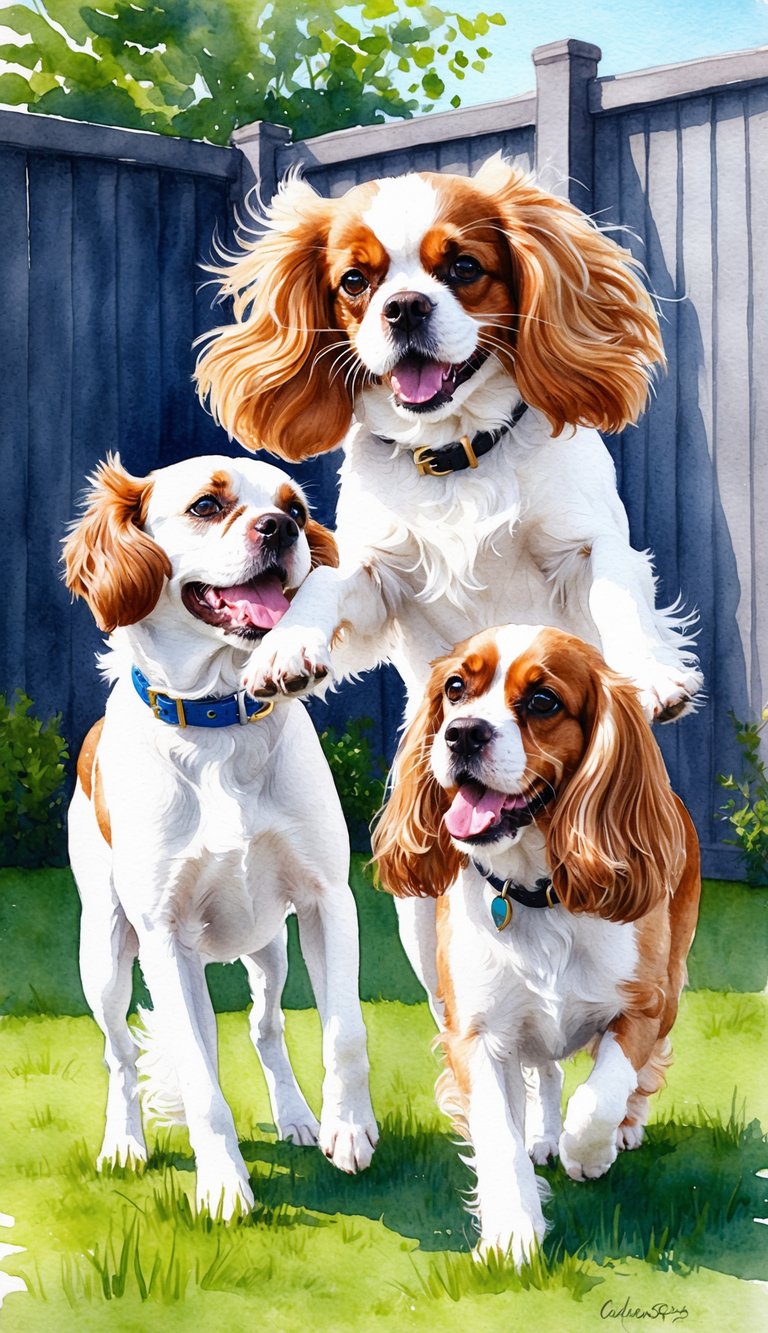
Thinking about getting a Cavalier King Charles Spaniel or a Coton De Tulear? The cost matters, no doubt.
You’ll need to consider the initial price and what you’ll spend on care over the years.
Initial Purchase or Adoption Costs
A Cavalier King Charles Spaniel from a breeder usually costs $1,200 to $2,500. Puppies from champion lines can be pricey—sometimes up to $4,000.
Adoption is usually less, around $200 to $500. The Coton De Tulear tends to be more expensive, with prices between $2,400 and $3,000.
Adoption fees for Cotons are typically under $500. If you’re after a show-quality pup, the price can climb even higher.
Puppy prices depend on the breeder’s reputation, health tests, and pedigree. Rescue costs often include vaccinations, and sometimes microchipping or spay/neuter.
For more details, you can check out price comparisons at Dogell.
Ongoing Care Expenses
Routine care for both breeds covers food, grooming, vet visits, and pet insurance. The Cavalier King Charles Spaniel often needs regular veterinary checks because of heart problems.
Plan to spend about $700 to $1,200 each year for routine care. That’s not a small chunk of change, but it’s pretty typical for small breeds.
Coton De Tulear grooming costs stand out thanks to their long, fluffy coat. Regular brushing, professional trims, and good shampoo all pile onto the annual bill.
Both breeds need vaccines, flea and tick prevention, and sometimes dental cleanings. Food costs stay moderate since these dogs are small.
Pet insurance, especially for Cavaliers, can really come in handy with possible health issues down the road. You can dig into more details at Dog Learn’s breed comparison.

